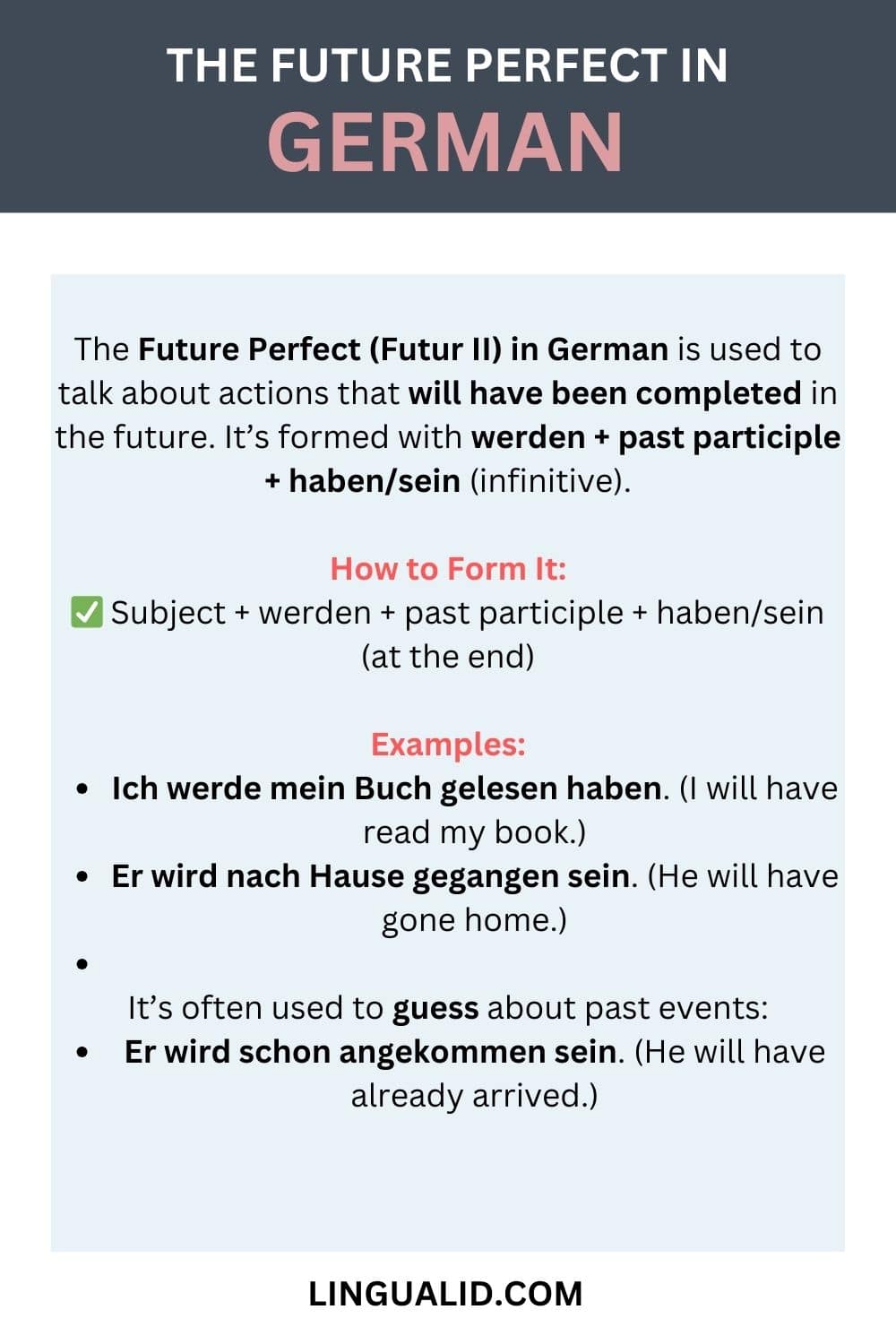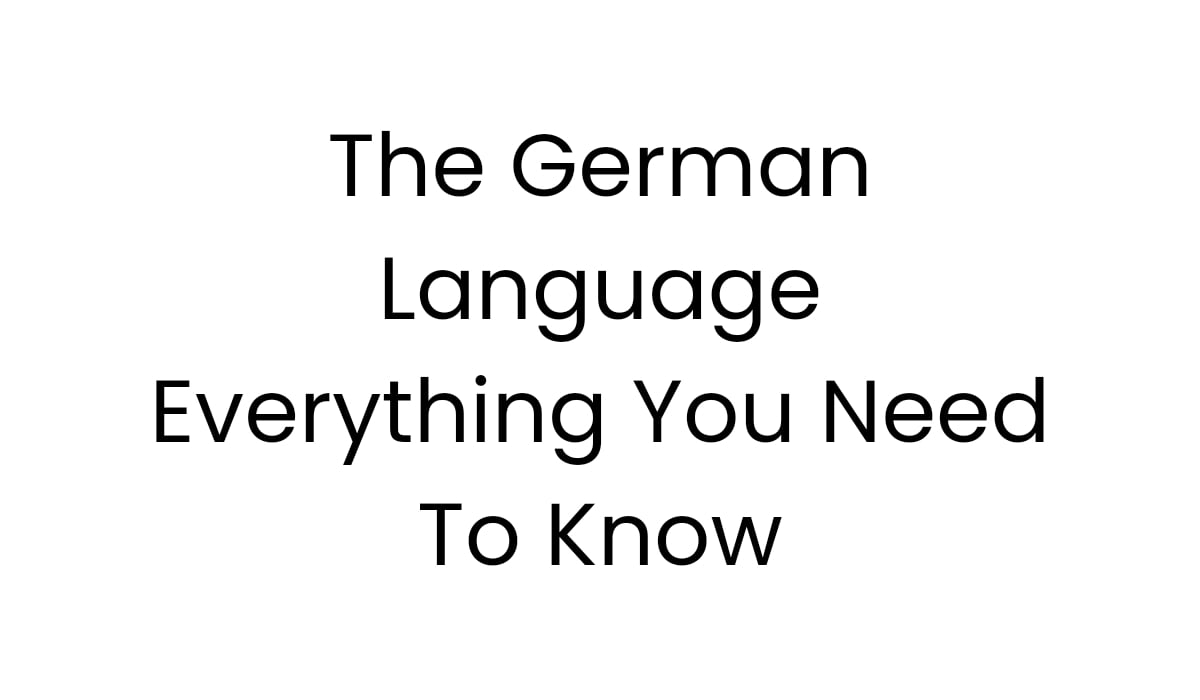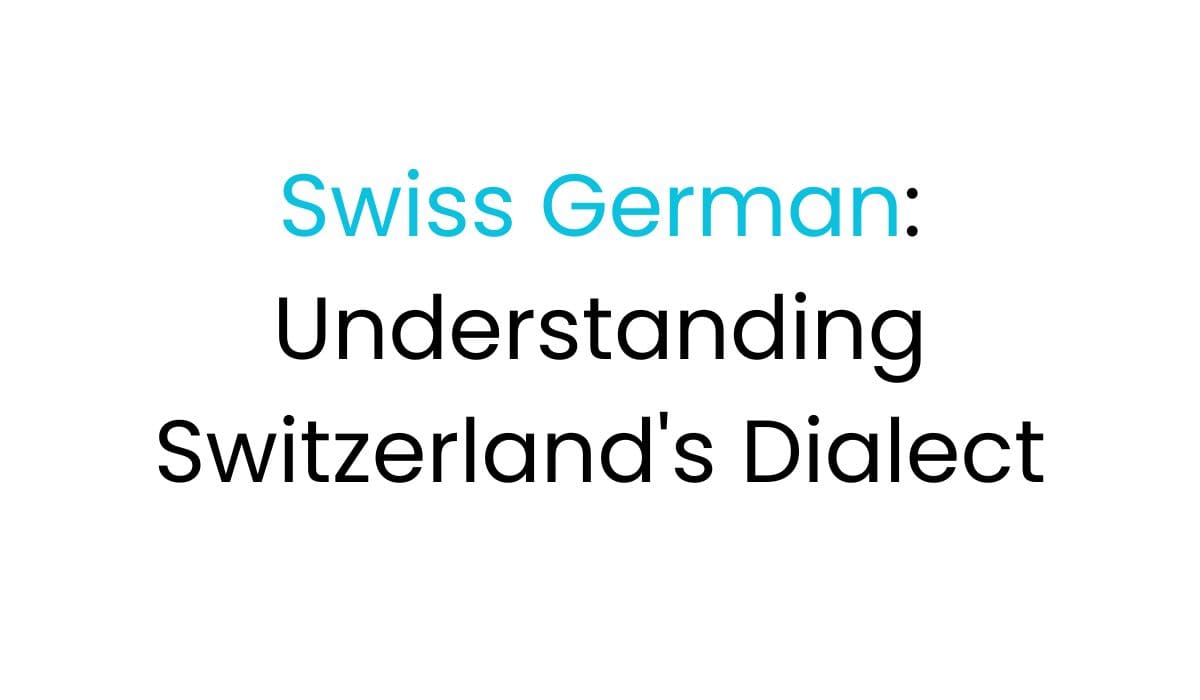Exploring German grammar tenses can seem tough. But, mastering the future perfect in German unlocks new ways to express yourself. This tense helps you describe complex time relationships with ease and style.
The future perfect (Futur II) shows actions that will be done by a certain time in the future. It’s not often used in everyday talk. Yet, it’s key in school and work, letting you talk about detailed time plans.
Learning this tense helps you talk better, moving from simple future plans to detailed time stories.

Key Takeaways
- Future perfect allows expressing completed actions in the future
- Essential for advanced German communication
- Combines “werden” with past participle
- Crucial in academic and professional contexts
- Demonstrates advanced language proficiency
- Key Takeaways
- What Makes Futur II Unique
- Common Usage Scenarios
- Importance in Written and Spoken German
- Conjugating "werden" in Present Tense
- Using Haben vs. Sein as Auxiliaries
- Forming Past Participles Correctly
- Specific Time Markers in German Future Perfect
- Temporal Clauses in Future Perfect
- Everyday Situations
- Formal Communication Contexts
- Academic Writing Strategies
- Business Communication Scenarios
- What exactly is the Future Perfect tense in German?
- How do I form the Future Perfect tense in German?
- When should I use haben vs. sein in the Future Perfect?
- What are some common time expressions used with Future Perfect?
- How does Future Perfect differ from Future I in German?
- Are there any common mistakes to avoid when using Future Perfect?
- Can I use Future Perfect in conversational German?
- How important is mastering the Future Perfect for German learners?
- Are there any tricks to remembering Future Perfect formation?
- In what professional contexts is Future Perfect most commonly used?
Understanding the German Future Perfect (Futur II)
The German Future Perfect tense, known as Futur II, is a complex grammatical structure. It lets speakers talk about actions done in the future from a certain point of view.
Futur II is different from other German tenses because it talks about actions done in the future. It’s not used much in everyday talk but is very important for formal writing and advanced speaking.
What Makes Futur II Unique
The Future Perfect in German is special because of its unique grammar. It has certain parts that make it more complex than other future tenses:
- Needs auxiliary verbs “haben” or “sein”
- Uses a past participle to show the action is done
- Has the conjugated “werden” verb in the second position
- Is good for talking about past events
Common Usage Scenarios
German speakers use Futur II in certain situations:
- When making guesses about past events
- For talking about actions done in the future
- In academic and professional writing
- In complex communication
Importance in Written and Spoken German
Futur II might not be used often in daily talk, but knowing it shows you’re good at German. It helps with clear time-related talk, especially in formal places like school papers, work talks, and detailed stories.
| Tense Type | Usage Frequency | Communication Context |
|---|---|---|
| Futur I | High | Everyday conversations |
| Futur II | Low | Formal/Advanced communication |
Learning about the future perfect in German can make your language skills better. It helps you talk about time in a more detailed and precise way.
Basic Formation Rules of Future Perfect in German
Creating the future perfect tense in German needs a clear structure. It might seem hard at first. But, it’s all about combining key parts to make future statements.
The main parts for the future perfect tense are:
- Conjugated form of werden in present tense
- Past participle of the main verb
- Auxiliary verb (haben or sein)
Knowing the werden + haben/sein + past participle rule is key. This rule is different from English. It’s important for understanding this tense.
| Verb Type | Auxiliary Verb | Example |
|---|---|---|
| Transitive Verbs | Haben | Ich werde gelesen haben (I will have read) |
| Motion/State Change Verbs | Sein | Ich werde gefahren sein (I will have driven) |
Forming past participles has its own rules. Weak verbs end in “ge…t”, and strong verbs in “ge…en”. Some verbs have special rules that you need to remember.
Getting good at the future perfect tense takes practice. It’s all about mastering German grammar. This tense helps you express future actions and completed tasks in a more detailed way.
Future Perfect in German: Essential Components and Structure
Learning the future perfect tense in German is complex. It involves understanding its parts and how they work together. This section will break down the key elements of the German future perfect. We’ll look at how it’s formed and used.
Using the future perfect in German requires mastering several important rules. These rules help form the tense’s structures. They involve how verbs interact with each other.
Conjugating “werden” in Present Tense
The verb “werden” is essential in German grammar. Its present tense forms are:
- ich werde (I will)
- du wirst (you will)
- er/sie/es wird (he/she/it will)
- wir werden (we will)
- ihr werdet (you all will)
- sie/Sie werden (they/you formal will)
Using Haben vs. Sein as Auxiliaries
Choosing the right auxiliary verb is key in German. It depends on the verb’s meaning:
- Haben is for transitive and reflexive verbs
- Sein is for verbs of movement or state change
Forming Past Participles Correctly
Forming past participles in German has its own rules:
- Regular verbs: “ge” + verb stem + “t”
- Strong verbs: “ge” + verb stem + “en”
- Verbs ending in “-ieren”: no “ge” prefix
- Separable verbs: “ge” placed after the prefix
Knowing these rules helps learners build correct future perfect sentences. It boosts their confidence in using German grammar.
Word Order and Sentence Structure in Futur II
Learning the Future Perfect tense in German requires knowing its special rules. The German language has strict rules for verb and auxiliary placement. This can be tricky for those learning German grammar tenses.
In main clauses, the Future Perfect in German has a clear word order:
- The conjugated form of werden sits in the second position
- The past participle appears in the second-to-last position
- The infinitive form of haben or sein comes at the sentence’s end
Here’s an example to show you the typical sentence structure:
| Component | Position | Example |
|---|---|---|
| Subject | First | Ich |
| Conjugated werden | Second | werde |
| Other Elements | Middle | bis morgen |
| Past Participle | Second-to-Last | gearbeitet |
| Auxiliary Verb | Last | haben |
By practicing and paying attention to these details, you’ll get better at using the Future Perfect tense in German. This will help you in both speaking and writing.
Time Expressions with Future Perfect
Learning about time expressions is key when using the future perfect tense in German. These phrases help show when something will be done in the future. Knowing how to use them makes your German better and clearer.
Time expressions with future perfect let you talk about exact times of future actions. They add clarity when you’re talking about things that will happen or be done.
Specific Time Markers in German Future Perfect
German has important time markers for future perfect:
- Bis (by): Shows a specific time of completion
- Spätestens (at the latest): Points out a deadline
- Frühestens (at the earliest): Shows the earliest time for something to be done
- Vor (before): Means an action is done before another
Temporal Clauses in Future Perfect
Temporal clauses connect different times. They use special words to link actions and add detail to the timing.
For instance, to say one action will finish before another, you use certain patterns. These patterns show the order of future events clearly.
By practicing these time expressions, you’ll get better at speaking German. You’ll be able to talk about complex future plans more accurately and smoothly.
Common Mistakes to Avoid When Using Future Perfect in German

Learning the future perfect in German needs careful attention. Many learners face challenges that can mess up their language skills. Knowing these common mistakes helps you avoid them and improve your German.
- Incorrect auxiliary verb selection
- Misplacing the past participle
- Forgetting to add “ge-” to regular verbs
- Struggling with irregular verb formations
Using the future perfect in German requires careful verb placement. About 70% of learners find it hard, especially in complex sentences. Precision is key when making future perfect sentences.
| Common Error | Correct Usage |
|---|---|
| Wrong auxiliary verb | Correctly choose haben/sein |
| Past participle placement | End of sentence in main clauses |
| Irregular verb formation | Memorize specific past participles |
Pay close attention to verb conjugations and choosing the right auxiliary verb. With practice, you can beat these challenges and get better at German grammar. Remember, making mistakes is part of learning.
- Practice regular verb conjugations
- Study irregular verb past participles
- Learn correct auxiliary verb usage
- Focus on sentence structure
By knowing these common mistakes in German grammar tenses, you’ll feel more confident using the future perfect tense.
Practical Examples and Conversational Usage
Learning the future perfect tense in German is key. It’s used in many ways, from everyday talks to formal writing. This tense helps us talk about future events in a clear way.
Using the future perfect in conversations is helpful. It lets us talk about time in a detailed way. Let’s see how it makes our words more precise.
Everyday Situations
In our daily lives, the future perfect is useful. It lets us say we’ve done something before another event happens. Here are some examples:
- Planning a meet-up: “Ich werde das Projekt beendet haben, bevor wir uns treffen.” (I will have finished the project before we meet)
- Discussing travel preparations: “Bis morgen werde ich den Koffer gepackt haben.” (By tomorrow, I will have packed the suitcase)
Formal Communication Contexts
In formal settings, the future perfect is even more important. It’s used in school and work to be clear and precise:
- Academic presentations: Showing when research will be done
- Business meetings: Talking about project goals and deadlines
- Professional email communications: Setting clear expectations for the future
Learning these examples will help you talk about time more accurately in German.
Comparing Future Perfect with Other German Tenses
German grammar tenses are rich and varied. The future perfect tense (Futur II) is special for talking about actions finished in the future. It’s not used often in daily talks but is key in more complex language.
Let’s look at the main differences between future perfect and other German tenses:
- Present Perfect (Perfekt): Most common in spoken German, used to describe past actions
- Simple Past (Präteritum): Primarily used in written German
- Past Perfect (Plusquamperfekt): Indicates actions completed before another past event
- Future I (Futur I): Expresses future intentions or assumptions
Here’s a comparative breakdown of these German grammar tenses:
| Tense | Usage Frequency | Primary Context |
|---|---|---|
| Present Perfect | Most frequent | Spoken communication |
| Simple Past | Less frequent | Written language |
| Future Perfect | Least frequent | Formal and complex expressions |
When comparing future perfect vs present perfect in German, the main difference is in time. Future perfect talks about actions finished in the future. Present perfect talks about past actions that are still relevant today.
Knowing these small differences helps learners speak and write German more accurately and with more flair.
Advanced Applications and Writing Practice
Learning to use the future perfect in German goes beyond basic rules. It’s key for those who write in academic and professional settings. This tense helps express future events in the past with precision.
Professionals in the German language see the future perfect as a tool for detailed communication. It helps writers craft complex stories and accurate professional documents.
Academic Writing Strategies
Academic writing needs careful language skills. The future perfect tense lets researchers talk about future outcomes and hypotheticals clearly.
- Describe research outcomes before they occur
- Present potential scientific developments
- Articulate complex theoretical projections
Business Communication Scenarios
In work settings, using the future perfect shows off your language skills and strategic thinking.
| Context | Future Perfect Application |
|---|---|
| Project Planning | Describing anticipated project completion |
| Financial Reporting | Projecting fiscal outcomes |
| International Negotiations | Discussing potential agreement scenarios |
Using the future perfect tense in writing can improve your skills. It shows you’re advanced in the German language.
Conclusion
Learning the future perfect in German is a big step in getting better at the language. The Futur II lets advanced learners talk about future actions in a detailed way. It helps them share their plans and actions that will be done in the future.
Getting good at German grammar takes time and practice. At first, the future perfect might be hard to understand. But, with more practice, it gets easier.
Learning German grammar tenses well means using them in real conversations. Practice making sentences that show you know how to use the future perfect. Remember, learning a language is always a journey of discovery and improvement.
See the challenge of German grammar as a chance to get better at speaking. With time and effort, the future perfect will become a key part of your German skills.
FAQ
What exactly is the Future Perfect tense in German?
How do I form the Future Perfect tense in German?
When should I use haben vs. sein in the Future Perfect?
What are some common time expressions used with Future Perfect?
How does Future Perfect differ from Future I in German?
Are there any common mistakes to avoid when using Future Perfect?
Can I use Future Perfect in conversational German?
How important is mastering the Future Perfect for German learners?
Are there any tricks to remembering Future Perfect formation?
In what professional contexts is Future Perfect most commonly used?
Oualid Cheddadi is the founder of Lingualid, a platform that inspires independent language learners worldwide, regardless of the language they are learning. The name “Lingualid” is derived from the Portuguese word for “language,” “língua,” and the last three letters of Oualid’s name, “Lid.”



